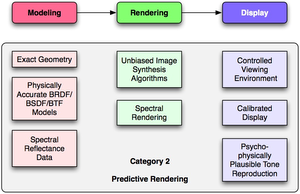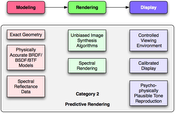Information
- Publication Type: Other Reviewed Publication
- Workgroup(s)/Project(s): not specified
- Date: 2009
- Booktitle: SIGGRAPH Asia 2009 Courses
- Location: Yokohama, Japan
- Conference date: 16. December 2009 – 19. December 2009
Abstract
This course intends to serve two closely related purposes: to provide an accurate definition of the term predictive rendering, the sub-discipline of computer graphics that attempts to provide reliable predictions of object appearance, and to present the technological foundations on which one can currently conduct research in this area.The first goal of the course – a clear definition of what predictive rendering actually is – seems to be necessary due to the extreme prevalence of its antonym, believable rendering. Practically all contemporary production computer graphics, as well as most current graphics research efforts, fall into the latter category. Coupled with the fact that in the collective mindset of the graphics community, the distinction between these areas has, for a variety of reasons, been somewhat blurry so far, a precise clarifying statement appears to be in order.
The second, much larger and technical part of the course then presents the foundations of current predictive rendering. Unlike believable rendering, where any technology that delivers visually convincing (as opposed to radiometrically correct) results is acceptable for a given task, a predictive pipeline suffers from the fundamental problem that all components – modeling, rendering, display – have to be of a uniformly high quality to ensure a predictive result. This fact has, over time, no doubt served to deter many researchers from entering this promising and interesting field, in which a large amount of work still lies ahead of us.
In the second part, we cover an entire predictive rendering pipeline, and for each stage present those – in some cases surprisingly few – graphics technologies that can be used in such a context. This course should enable anyone with a solid background in graphics to bootstrap a basic predictive rendering environment, with which further research, or perhaps even specialised production work, can be conducted.
Additional Files and Images
Weblinks
No further information available.BibTeX
@inproceedings{wilkie-209.pr,
title = "Predictive Rendering",
author = "Alexander Wilkie and Andrea Weidlich and Marcus Magnor and
A. Chalmers",
year = "2009",
abstract = "This course intends to serve two closely related purposes:
to provide an accurate definition of the term predictive
rendering, the sub-discipline of computer graphics that
attempts to provide reliable predictions of object
appearance, and to present the technological foundations on
which one can currently conduct research in this area. The
first goal of the course – a clear definition of what
predictive rendering actually is – seems to be necessary
due to the extreme prevalence of its antonym, believable
rendering. Practically all contemporary production computer
graphics, as well as most current graphics research efforts,
fall into the latter category. Coupled with the fact that in
the collective mindset of the graphics community, the
distinction between these areas has, for a variety of
reasons, been somewhat blurry so far, a precise clarifying
statement appears to be in order. The second, much larger
and technical part of the course then presents the
foundations of current predictive rendering. Unlike
believable rendering, where any technology that delivers
visually convincing (as opposed to radiometrically correct)
results is acceptable for a given task, a predictive
pipeline suffers from the fundamental problem that all
components – modeling, rendering, display – have to be
of a uniformly high quality to ensure a predictive result.
This fact has, over time, no doubt served to deter many
researchers from entering this promising and interesting
field, in which a large amount of work still lies ahead of
us. In the second part, we cover an entire predictive
rendering pipeline, and for each stage present those – in
some cases surprisingly few – graphics technologies that
can be used in such a context. This course should enable
anyone with a solid background in graphics to bootstrap a
basic predictive rendering environment, with which further
research, or perhaps even specialised production work, can
be conducted.",
booktitle = "SIGGRAPH Asia 2009 Courses",
location = "Yokohama, Japan",
URL = "https://www.cg.tuwien.ac.at/research/publications/2009/wilkie-209.pr/",
}

